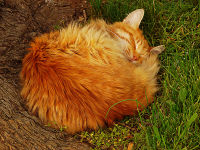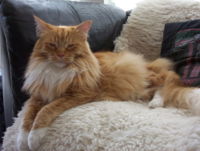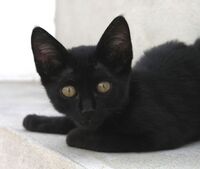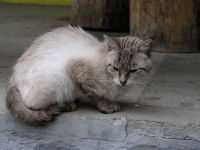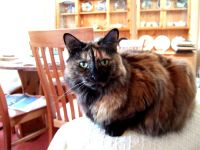Cat colors: Difference between revisions
imported>Nancy Sculerati MD |
imported>Nancy Sculerati MD |
||
| Line 2: | Line 2: | ||
=Tabby pattern= | =Tabby pattern= | ||
In house [[Cat|cats]], the "default" pattern to the coat is a tabby pattern, or more precisely, one of ''four'' tabby patterns. All involve some sort of striping, and each can be most easily identified by the appearance of cat's fur on the sides of its body. Every one of the of tabby patterns includes tabby markings on the face and so these lines, that so remind some people of tattoos or make-up, are of no help in distinguishing one tabby pattern from another. | |||
==Classic tabby== | |||
A "classic tabby" (called "blotched tabby" in the UK) cat has thick irregular side stripes, that make a bold swirled pattern (like marble pound cake). | |||
==Mackerel tabby== | |||
The "mackerel tabby" has narrow stripes that run in parallel lines down its sides. Many people refer to pet cats with this mackerel tabby pattern as being a "tiger" cat. | |||
==Spotted tabby== | |||
A "spotted tabby" has spots, these may be large spots, small spots, or the rectangles made by broken mackerel stripes. | |||
==Ticked tabby== | |||
A "ticked tabby" (also called "Abyssinian tabby" or "agouti tabby") does not have either stripes or spots on its body fur. This is the color of the Abyssinian cat, but it also appears in non-purebreds and does not mean the cat is Abyssinian. | |||
A "ticked tabby" (also called "Abyssinian tabby" or "agouti tabby") does not have either stripes or spots on its body fur. This is the color of the Abyssinian cat, but it also appears in non-purebreds and does not mean the cat is Abyssinian. | |||
Revision as of 19:42, 22 January 2007
The genes for coat color in cats follow a similar relationship as do those for horse colors and dog coats. Some of the genes code for the production of pigments that turn hairs black, or red, other genes either entirely exclude or limit the amount of color that can be incorporated in the coat. Currently, DNA tests for these genes are becoming available.
Tabby pattern
In house cats, the "default" pattern to the coat is a tabby pattern, or more precisely, one of four tabby patterns. All involve some sort of striping, and each can be most easily identified by the appearance of cat's fur on the sides of its body. Every one of the of tabby patterns includes tabby markings on the face and so these lines, that so remind some people of tattoos or make-up, are of no help in distinguishing one tabby pattern from another.
Classic tabby
A "classic tabby" (called "blotched tabby" in the UK) cat has thick irregular side stripes, that make a bold swirled pattern (like marble pound cake).
Mackerel tabby
The "mackerel tabby" has narrow stripes that run in parallel lines down its sides. Many people refer to pet cats with this mackerel tabby pattern as being a "tiger" cat.
Spotted tabby
A "spotted tabby" has spots, these may be large spots, small spots, or the rectangles made by broken mackerel stripes.
Ticked tabby
A "ticked tabby" (also called "Abyssinian tabby" or "agouti tabby") does not have either stripes or spots on its body fur. This is the color of the Abyssinian cat, but it also appears in non-purebreds and does not mean the cat is Abyssinian.
Tabbies come in many different colors, best determined by checking the colors of any stripes as well as the color of the tail tip - which should match. The background colors in tabbies varies tremendously from cat to cat, even of the same tabby color. The ground color (also called "the agouti hairs" will b a faded gray in some and a rich orange in others.
The "brown tabby" has black stripes on a brownish or grayish ground color. The black stripes may be coal black, or a little bit brownish.
The "blue tabby" has gray stripes on a grayish or buff ground color. The gray stripes may be a dark slate gray, or a lighter blue-gray.
The "red tabby"
The red tabby has orange stripes on a cream ground color. The orange stripes may be dark reddish orange, or light "marmalade" orange.
The "cream tabby" has beige or sand colored stripes on a pale cream ground color, giving it a pastel effect. The "silver tabby" has black stripes on a white ground color. The roots of all the hairs are white.
White pattern (called spotting) caused by the S gene
Recessive ss: no white pattern. The cat is one color, called “self” in the UK, and “solid” in the U.S.
The ventral portion of the cat is the chin, neck and belly. Ventral white spotting is inherited as a separate trait from overall coat color.
“In cats, the white spotting locus (S), appears to affect melanocyte migration. Heterozygous animals (Ss) have a ventral white pattern (Whiting 1919), not spots, as the name would suggest. This ventral white pattern, known as bicolour by cat fanciers, is considered to be dominant to solid colour, with an additive effect of the dominant allele. Full solid colour (ss) is recessive, while the van pattern, in which colour is limited to the head and tail regions, is postulated as homozygous SS (Kuhn & Kroning 1928). Various other white spotting phenotypes show spotting at the ventral midline, such as lockets and belly spots, or white at the extremities, such as gloves and mittens. These other white presentations are anticipated to be allelic to ventral white (Whiting 1919). In addition, dominant white (W), which is associated with blue eye colour and deafness in the cat, may be allelic to white spotting (Whiting 1919; Bergsma & Brown 1971); however, epistasis has complicated allele assignments.” Reference: M. P. Cooper, N. Fretwell, S. J. Bailey, L. A. Lyons: White spotting in the domestic cat (Felis catus) maps near KIT on feline chromosome B1. Animal Genetics, Volume 37, Issue 2: 163-165. doi: 10.1111/j.1365-2052.2005.01389.x
Solid (self) colors (recessive ss)
Black Blue (maltese) This color is the color of This is the color of the Russian Blue, Chartreux, and Korat, but also is found in Maine coons, and many other cats. A "solid white" is white all over. Sometimes white cats have blue eyes, sometimes they have green or gold eyes, and sometimes one eye is blue and one eye is green or gold! This last color is called "odd-eyed white."
Dominant S gene phenotypes
A "mitted" cat just has white paws. A cat with a white spot on its chest has a "locket." A cat with one or more little white belly spots has "buttons." A "bi-color" is about half white. A "harlequin" is mostly white with several large patches of color. A "van" is almost all white with color patches only on the head and tail.
Albino Cats
Total Albino
Complete albino cats are not common, in fact, they have only been sporadically reported in the animal science literature. All of these cats have had white fur and pink skin, some have had blue and others have had pink eyes. It is possible that more than one gene is involved in albinism in cats.
Partial albino: Point coloration and temperature dependent tyrosinase
However uncommon complete albinism is, partial albinism is a very well-recognized trait in the domestic cat. Partial albinism gives the Siamese and Burmese cats their "points" and both the genes and the proteins responsible for producing it have been identified. Point Coloration: Tyrosinase mutations This coloration is a form of albinism. Color is absent in the warm areas of the body, and pigment is expressed only in the colder regions of the body, the ears, tails and paws.
Tyrinosinase is an enzyme that acts on the amino acid tyrosine in metabolism, and is required for melanin production in mammals. If this enzyme has inborn variations, it is responsible for the point coloration seen in Siamese and Burmese cats, and breeds whose distinctive coloration originated from crosses with these cats, such as the Himalayan. “This temperature-sensitive colouration causes a 'mask' on the face and the phenotype is commonly referred to as 'pointed'. Burmese is an allelic variant that is less temperature-sensitive, producing more pigment throughout the torso than Siamese.” “The SNP associated with the Siamese phenotype is an exon 2 G > A transition changing glycine to arginine (G302R). The SNP associated with the Burmese phenotype is an exon 1 G > T transversion changing glycine to tryptophan (G227W). The G302R mutation segregated concordantly within a pedigree of Himalayan (pointed) Persians. All cats that had 'pointed' or the Burmese coat colour phenotype were homozygous for the corresponding mutations, respectively, suggesting that these phenotypes are a result of the identified mutations or unidentified mutations that are in linkage disequilibrium. Because the same mutations were identified in different breeds with similar phenotypes, the mutations are likely to be identical by descent rather than multiple mutation events occurring at the same site.” The phenotype of this color pointing expresses pigment only in the colder regions of the body, the ears, tails and paws.
The same gene that gives the Himalayan and Siamese cats their pointed coloration is apparently responsible for that same pattern of color in the Himalayan rabbit. (Aigner B., Besenfelder U., Muller M. & Brem G. (2000) Tyrosinase gene variants in different rabbit strains. Mammalian Genome 11, 700–2.)
Points can have different colors, and different shadings
Points can be "self" (solid) or have patterns (tabby)
Sex-linked: Females only - tortoiseshell and calico cats
L. A. Lyons, D. L. Imes, H. C. Rah, R. A. Grahn: Tyrosinase mutations associated with Siamese and Burmese patterns in the domestic cat (Felis catus). Animal Genetics, Volume 36, Issue 2: 119-126. doi: 10.1111/j.1365-2052.2005.01253.x
Barsh G.S. (1996) The genetics of pigmentation: from fancy genes to complex traits. Trends in Genetics 12, 299–305.
